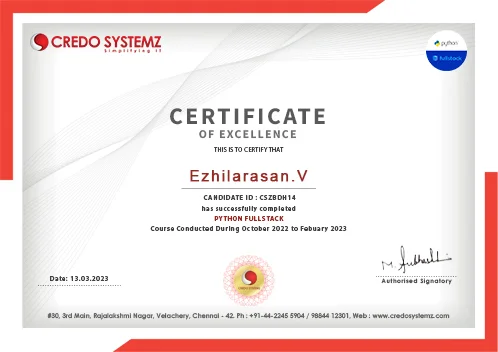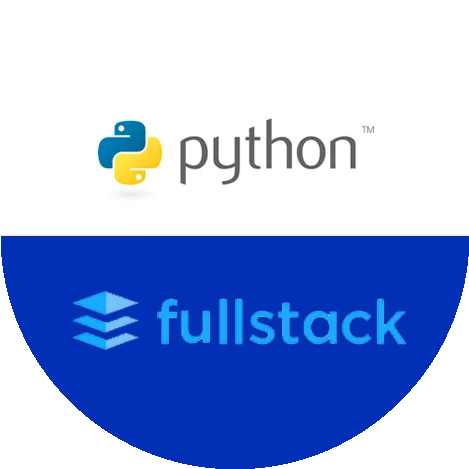Skip to content
Hello, welcome to my blog!
Training
Why Choose a Python Fullstack course from Credo?
Credo Systemz Python Full Stack training in Chennai is the standard course to expertise in Full Stack development using Python. This Python Full Stack Course in Chennai assists in gaining the in-built knowledge of Full Stack with Python programming. Gain proficiency in Full Stack with Python using our Practical Training program. Our Python Full Stack Training is framed from scratch to meet the market standard.
Find out what our past customers have to say about credo and their experiences with us
Python Fullstack Training Curriculum
Credo Systemz Python Full Stack certification course in Chennai provides a well structured curriculum from basics. This Python Full Stack training covers the necessary modules to master Full stack with Python
Download curriculum
HTML 5, CSS, BOOTSTRAP JS & TS Curriculum
Introduction – Web
What are the different Types of Web Apps overview?
Introduction to HTML
Define HTML Structure Difference between Tag vs Element Difference between Semantic vs Non-semantic elements Difference between Block level elements vs Inline elements HTML Elements HTML Forms & its Attributes HTML Input Elements HTML Global Attributes HTML Element Specific Attributes
CSS
What is CSS?
Understanding the CSS Syntax. CSS Selectors. How To Add CSS in HTML. Cascading Order. CSS Colors. CSS Backgrounds. CSS Borders CSS Margins CSS Padding CSS Height and Width CSS Text, Fonts, Links, Tables CSS – Float and Clear The display: inline-block Value
BOOTSTRAP
What is Bootstrap?
Get Start with Bootstrap Containers Grid System Structure of a Bootstrap Grid Bootstrap Colors Bootstrap Tables Bootstrap Jumbotron Bootstrap Alerts Bootstrap Buttons Bootstrap Navs Define Navigation Bars Bootstrap Forms Bootstrap Modal
Javascript Course Content
Chapter 1: Introduction – Javascript
Client Side Scripting
Define JavaScript
Variables in JavaScript
Rules to create variables in JS What is varibale declaration & definition? Define Variable Scopes List of Data Types in JavaScript
Chapter 2: Introduction – JS Events,
What are Event in JS?
Onload, Onunload, Onsubmit, OnFocus, Onchange Event, Onblur Event, Onmouseover, Onclick, Ondbclick Events, etc., Chapter 3: JavaScript Functions
About Function
Define Functions in JS What are the functions available in JS? Define Function Invocation Types How to pass Arguments & Parameters in Function?
Chapter 4: Explain about Inbuilt methods in JS
Explain String inbuilt methods Explain Number and Math inbuilt methods Explain Array inbuilt methods Chapter 5: Arrays in JavaScript
Array’s Overview
How to Manipulate (Add, Edit, Delete) Array Elements ? Define Array Sort Chapter 6: Objects in JavaScript
JS Object – Overview.
Object Structure in JS. What are Object Properties and Methods. How to add New Properties and Methods in Existing Object ? Object Creation ways in JS Chapter 7: Conditional and loops in JavaScript
Conditions Statements (If, If Else, Switch)
JavaScript Loops (For Loop, While Loop, Do While Loop and for in loop) Chapter 8: HTML DOM Manipulation
Introduction – DOM
Methods of Finding HTML Elements. Methods of Finding HTML Elements. Methods of Changing HTML Elements. Methods of Add/Delete HTML Elements. Event Listener Overview.
Angular 14 Course Content
Chapter 1:Angular Introduction
Angular- Definition
Difference between Framework & Library?
History of Angular and its versions.
Why Angular?
What are the Features of Angular.
Define Single Page Application
What is the Difference between SPA & Traditional Application?
Define MVC
How MVC works in Client & Server sides?
Chapter 2: Angular Environment setups
What is Angular CLI?
What is the Purpose of the CLI?
Angular CLI installation.
CLI vs Without CLI Overview.
Create an Angular App by using CLI.
Compiling the Angular App & Open it in a browser.
Angular app Bootstrapping process.
About Angular libraries
Brief explanation about the structure of the Angular App. Chapter 3: Main Building Blocks of Angular
Chapter 4: Angular Modules
Angular Module Overview.
Define the Importance of the Module?
Why Modules?
Root Module, Core Module, Feature Module and Shared Module – Overview.
How to create Angular Modules?
@NgModule Decorator & its Meta data properties – Overview.
How to Import & Export Module?
Chapter 5: Components
Angular Component – Overview.
@Component decorator & its Meta data properties.
Root Component – Overview
How to create a Component manually and through CLI?
Component’s Structure overview.
Component in an Action
What is Instance of the Component?
What are the ways to render a Component in the view?
Component Lifecycle Hooks.
Nested or Parent & Child Component – Overview
Components Interactions – overview.
How to pass Data from Parent to Child & Child to Parent?
Chapter 6: Data Binding, Property Binding, Event Binding & 2-way Data Binding
Data Binding Introduction
Define String Interpolation.
Property Binding – Overview.
what is Custom Property Binding?
Overview of Event Binding.
String Interpolation VS Property Binding
Two-way Data Binding – Deep dive.
Implementing the 2-way Data Binding and understanding the process.
Style Binding, Class Binding.
Element reference and $event service in Angular.
Define Event Filtering
Chapter 7: Services
Introduction – Service.
Importance of Service.
How to create Services in Angular?
What are the ways to Provide Services in Angular?
Dependency Injection – Overview.
How to use Dependency Injection?
Singleton Object – Overview
Singleton Obj VS Regular Obj
Define Providers
What is @Injectable()?
Registering a Service in Providers VS @Injectable() Decorators
Define Hierarchical DI
Chapter 8: Directives & Custom Directives
Directives – Introduction.
Component VS Directives
What are the Different kind of Directives available in Angular?
Difference between Structural & Attribute Directives.
Overview of All Structural & Attribute Directives.
– ngIfDifference between ngIf & hidden directives.
How to create Custom Directives? @Directive Decorator and its Meta data properties.
How to pass Input property to the custom directive?
How to receive Input property from the outside of the directive?
@Input decorator and its methods.
What is ElementRef and its purpose? @HostListner decorator overview. Chapter 9: Pipes in Angular
What is Pipe in Angular?
what are the purpose of the Pipes?
Difference between Pipes & Directives.
Detailed explanation of the below Pipes,
What is Pure Pipe & Impure Pipe?
How to create Custom Pipes?
What is chaining Pipes?
What is Parameterized Pipe? Chapter 10: Components Communication
Overview of Components Interaction.
Share data between components by using Service.
Component Interaction from Parent to Child.
Component Interaction from Child to Parent.
@ViewChild decorator overview
@Input & @Output decorator overview
Define Custom Event Binding
Components Interaction by using Event Emitter & Subject and observable Chapter 11: Event Emitter and other special Directives
What is Event Emitter?
When to use Event Emitter?
How to transfer data with Event Emitter?
How to create Custom Events and Trigger?
OverView Encapsulation
What is ng-content and its purpose?
ng-container Directive overview. Chapter 12: Template Driven Form in Angular
Template Driven Form
Purpose of Form in Angular.
How to setup a form in Angular?
What is form control and how to set it?
Define ngForm
How to Access form values?
What are the form states available in Angular?
TD form Validations.
HTML5 Validation vs Angular form Validation.
How to set prepopulate values in form fields?
Setup One-way data binding in Angular. Chapter 13: Reactive Form in Angular
What is Reactive Form?
Difference between Template Drive & Reactive Form
What is form group & form control?
How to sync view & Reactive form TS?
What is Patch Values & Set Values?
How to attach Dynamic Validations?
How to get Reactive from Values?
Create Dynamic Form by using Reactive Form Chapter 14: Service and Dependency Injection in Angular
Service in Angular
Create & configure Service in Angular.
How to do Dependency Injection in Angular?
Define Singleton Object
Multiple DI in single Class. Chapter 15: Routing in Angular
What is Routing?
How Routing makes our App into SPA?
How to configure Routing in an Application?
Load our components dynamically based on url path.
How to create Child Route?
Navigating to other links programmatically.
Passing Parameter to the Routes.
Static Route vs Dynamic Route.
Define Fetching Route Params.
Router Directives overview
Client-side authorization using Route Guard
Chapter 16: HTTP & Observable in Angular
HTTP Client in Angular.
REST API – Overview
How to establish HTTP request to Server side.
How HTTP Mechanism works?
What are the methods available in HTTP?
Define Observable & Observer
What are the call back methods available in Observable?
Creation of a Custom Observable
Define next(), error() and complete()
How to send Query Params & Custom Headers?
How to connect any backend & APIs?
Define CORS
How to resolve CORS errors?
Chapter 17: Authorization in Angular & JWT
Client side Authorization vs Server side Authorization.
Server side Authorization by using JWT Token.
Set JWT Key Expiry time.
HTTP interceptors – Overview.
How to configure HTTP interceptors?
Chapter 18: File Upload in Angular
Angular form setups for File Upload.
FormData() in Angular
Server side setups for File Upload.
Multer NPM in Node.
How to use Multer NPM as middleware in Node?
Attach the Multer middleware in server-side routing.
Chapter 19: Real-time Project in Angular
During the course we will take one Real-time E-commerce application and apply all the above sections into the project. In the project Front-end will be in Angular and Back-end will be in Node JS. On top of the Node JS we will write Express JS as a REST Api. For Database, we choosed MongoDB for CURD Operations.
View More
Flexible Mode of Training and Payment
Hear it from our customer!!
Our Python Fullstack Training Overview
Our Python Full Stack Certification training in Chennai assists in Professional skills development using hands-on practices. This Python Full Stack Course offers 100% practical training with live sessions. Attend Our Python Full StackTraining Demo to experience the live training sessions
View More
Training Benefits!!
Credo Systemz Python Full Stack Training in Chennai provides complete training to pursue a successful Full stack Career path. Learn the industrial skill set to be an expert professional using Our Python Full Stack Course in Chennai. We assure top trainers, certification support for gaining the knowledge of Python Full Stack. Gain the industrial experience of Python Full Stack using our hands-on practices
5-15%
5-15% Chances of immediate placements.
10-15%
10-15% increase in salary.
~30%
30% of job market is open for Python Full Stack developers.
Testimonials
Credo Systemz Python Full Stack training in Chennai offers practical training to acquire the skills of Full stack with Python programming. It is effective and provides industrial practices. Thank you Credo Systemz.
Anuviha
I completed Python Full Stack training at Credo Systemz using real world practices. This Python Full Stack Course in Chennai offers hands-on practices to become a full stack developer using python. It includes career support and certification.
Karthiga
Join Us
CREDO SYSTEMZ provides the Best Python Full Stack Training in Chennai to promote you into a skilled FullStack professional with 100% Free Placement Support.
Join Now
Get Industry Recognized Certification
Credo Systemz’s certificate is highly recognized by 1000+ Global companies around the world. Our Python Full Stack certification showcases the in-built knowledge and skills of Full Stack using Python.
Benefits of Python Fullstack Certification
To demonstrate the Proficiency of Python Full Stack with its skills.
To add weightage to your Professional resume and pursue the best career path.
To stand out in the job market with guaranteed performance.





